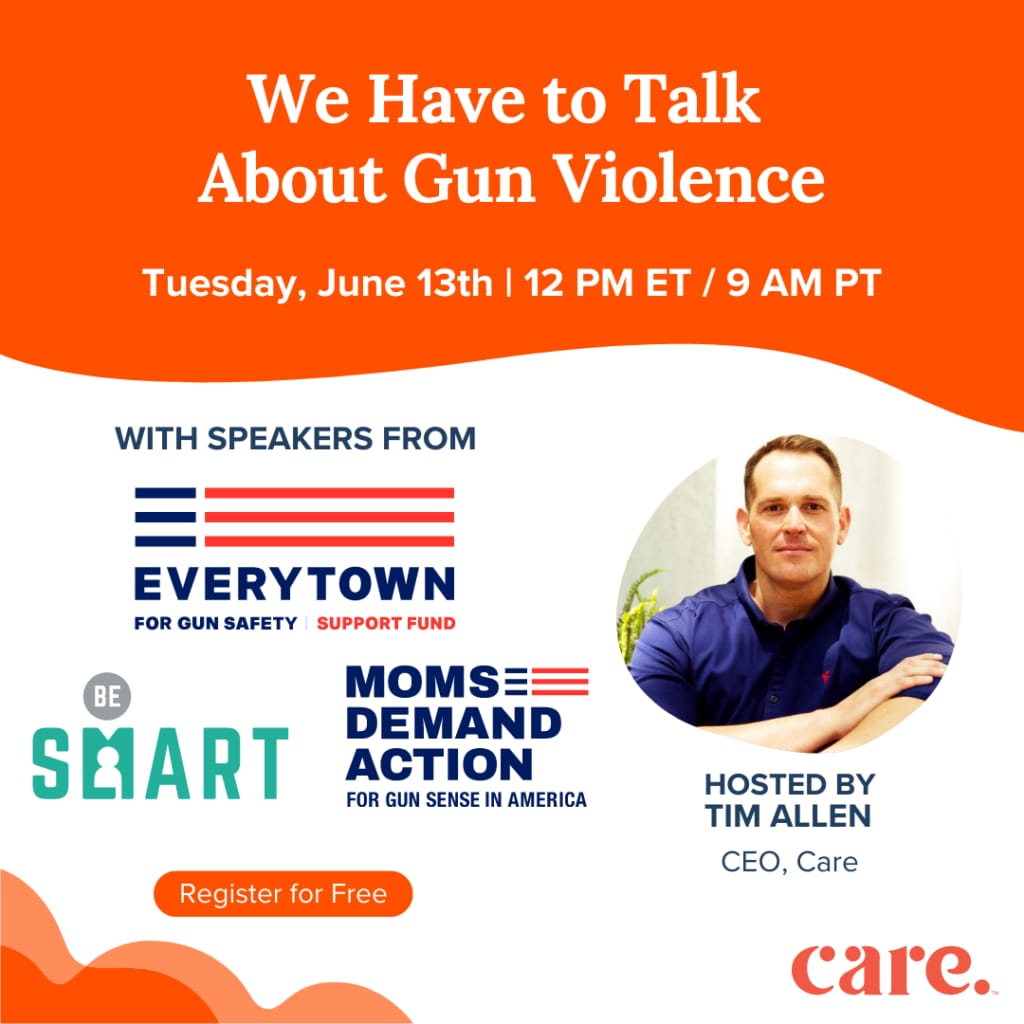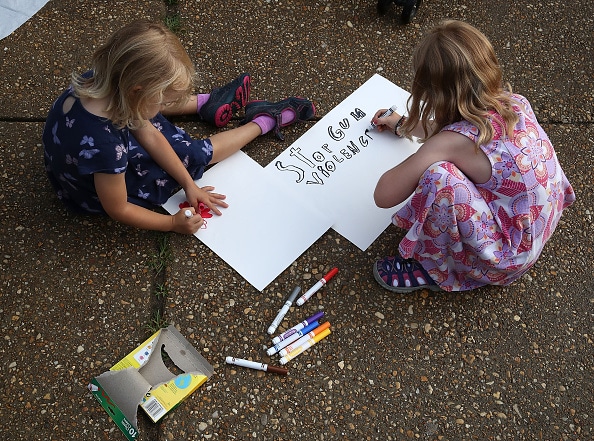It’s impossible to ignore the impact of gun violence in the U.S. During any given week, there are new reports of school violence, mass shootings, accidental deaths and other gun-related tragedies, and these events are so numerous and occur with such regularity that they’ve become a fixture in American life.
Every day in the U.S., more than 110 people are killed with guns, and more than 200 are shot and wounded. The Centers for Disease Control and Prevention (CDC) reports that more than 45,000 Americans died from gun violence in 2020, the most recent year for which complete data is available, and the rate of gun violence continues to grow. Within the first five months of 2023, more than 17,000 people have lost their lives to guns.
The extreme rates of gun violence in our country affect Americans of every age and race. Shootings happen in grocery stores, at the movie theater, during parades and community celebrations and even in Kindergarten classrooms. In June, Congress passed the first updated gun legislation in nearly 30 years. But it’s clear that much more work is needed to adequately address the increasing rates of gun violence in the U.S. and the record numbers of Americans who are being killed and wounded every single day.
To better understand the scope of the problem, here’s a look at the most recent data on gun violence and who is most at risk.
Guns are the leading cause of child and teen death in the U.S.
In 2020, gun violence surpassed car accidents to become the leading cause of death for children and teens ages 1 to 18. The U.S. is now the only country among its peer nations where this is the case.
School shootings are among the biggest concerns for parents and caregivers. According to a report by Education Week, there were 51 school shootings in 2022. Despite those alarming numbers, mass shootings still represent less than 1% of firearm deaths in the U.S. among all age groups, and they are not the only threat to kids.
Here are the other ways American kids and adolescents are most impacted by guns:
- More than 2,100 children and teens die by gun homicide every year.
- An average of 1,200 children and teens die annually from gun suicide.
- An average of 110 children ages 0-14 die in unintentional shootings each year.
- More than 3 million children witness gun violence annually.
The rate of gun violence is increasing
In 2022, a record number of more than 6,000 children and teens were killed or wounded by guns. The rates of gun violence have been trending upward since 2020 when, according to the Pew Research Center, the U.S. had 13.6 gun deaths per 100,000 people — the highest rate since the mid-1990s.
The overall rate of gun deaths among kids younger than 19 increased 30% in 2020, a figure that Johns Hopkins University researchers attribute to both a dramatic rise in the overall number of gun homicides (40%) and an increase in the gun suicide rate (11%).
From the year 2000 to 2020, 31,780 American children died from gun violence. Sadly, the rate of gun-related child deaths in the U.S. increased during that time period, even as it declined in our peer nations.
Read more:
Unsecured firearms claim lives
An estimated 4.6 million children live in a home with at least one unlocked and loaded firearm, according to a survey published in the Journal of the American Medical Association.
Easy access to firearms is associated with an increased risk of death by suicide among adolescents. Kids who can access guns may also be more likely to become the victim or perpetrator of an unintentional shooting.
There were at least 2,070 unintentional shootings by kids under 18 from 2015-2020, according to Everytown, a nonprofit that advocates for common sense gun laws. Of these incidents:
- 7 out of 10 unintentional shootings happened in homes.
- More than 1 in 4 unintentional shootings were done by kids 5 and under
- In 2020 alone, at least 125 toddlers and preschoolers shot themself or someone else.
- 83% of unintentional shooters were boys and 76% of victims were boys and men.
Black children and teens are 14 times more likely than white children and teens to die by gun homicide.
—EVERYTOWN DATA
People of color are disproportionately impacted by gun violence
Gun violence doesn’t impact all communities equally. While gun violence is affecting kids nationwide in record numbers, the data also shows that Black children and teens are 14 times more likely than white children and teens to die by gun homicide.
Gun violence by police also disproportionately impacts people and communities of color. In 2020, a study published in the Journal of Epidemiology and Community Health declared police shootings “a public health emergency that contribute to poor health for BIPOC [Black, Indigenous and People of Color].”
The study reviewed data on police shootings from 2015 to 2020 and found that:
- Unarmed Black civilians are 3 times more likely than white civilians to be shot and killed by police.
- The rate of unarmed Hispanic civilians shot by police is 45% higher than that of white civilians.
- Native Americans are 3 times more likely than white people to be shot and killed by police.
In 2020, a separate study by Children’s National Hospital in Washington, D.C., reported that Black children between the ages of 12 and 17 are 6 times more likely than white children to be the victims of a fatal police shooting.
The U.S. leads in gun ownership — and gun violence
The U.S. has a ratio of 120.5 firearms per every 100 residents, according to the Small Arms Survey, an independent firearms research project based in Switzerland. Along with this, our country also has some of the highest rates of gun violence in the world:
- Americans are 25 times more likely to be killed in a gun homicide than people in other high-income countries.
- 58% of American adults say they or someone they care for has experienced gun violence.
- A higher percentage of homicides are carried out by guns in the U.S. than in the UK, Canada and Australia combined.
If U.S. gun violence continues at its current rate, a study in the journal Preventitive Medicine estimates that nearly every American will know at least one victim of gun violence in their lifetime.

Sign up for our free webinar here
What you can do to aid in the fight against gun violence
By almost any measure, it’s clear the U.S. has a serious gun violence problem. But that doesn’t mean Americans just have to accept the current state of things. There are thousands of activists and ordinary citizens working to make people safer every day. Here’s what they say you can do to get involved and make a difference:
- Join a group like Moms Demand Action, Stand With Parkland, Moms Rising or other anti-violence groups actively pushing for change.
- Participate in a Be SMART training to learn about secure firearm storage and how to protect kids.
- Know your representatives’ records on gun violence and contact them regularly to ask what they’re doing to address gun safety in your community.
- Talk with your child’s school leaders about their plans to keep kids safe.
- Support common sense gun legislation.
A recent analysis by the RAND corporation found that implementing just three changes — safe storage laws, restrictions on concealed carry and laws encouraging non-lethal self defense — can reduce the number of gun deaths in a given state.
Americans may differ in their approaches to fighting gun violence, but there are so many steps we can take to save lives and create a safer world for our families.




